In this article, we will provide an overview of Google Analytics goals and try to answer the most frequent questions. Before getting started with the heart of the matter, let’s remember what Google Analytics is.
About Google Analytics
Before defining Goals in Google Analytics, let’s remember what is Google Analytics. Google Analytics is one of the services offered by the American web and technology company Google. Launched in 2005, Google Analytics has quickly become one of the most notable web-based analytics tools. The primary functionalities of this service include the following: website traffic reports, performance analyses, visitor behavior evaluation, and ROI (Return on Investment) measurements. Therefore, it is one of the favorite tools of many marketers, especially those using SEO (Search Engine Optimization) strategies. Anyone having a Google account can use the service, which is a freemium one: most of the basic features are free of charge, whereas advanced ones require a fee. You may also want to read our How to Improve SEO With Google Analytics article.
Defining Goals in Google Analytics
Actually, the term goal is pretty self-explanatory in the present context. It means that whenever you perform X or Y action through Google Analytics, you will most likely want to evaluate how successful or effective that particular action was. We should add that setting up goals for this platform involves an interactive process. So it is not only about you, but also (and even mostly) about your website visitors. Of course, we are not talking about random or accidental interactions here.
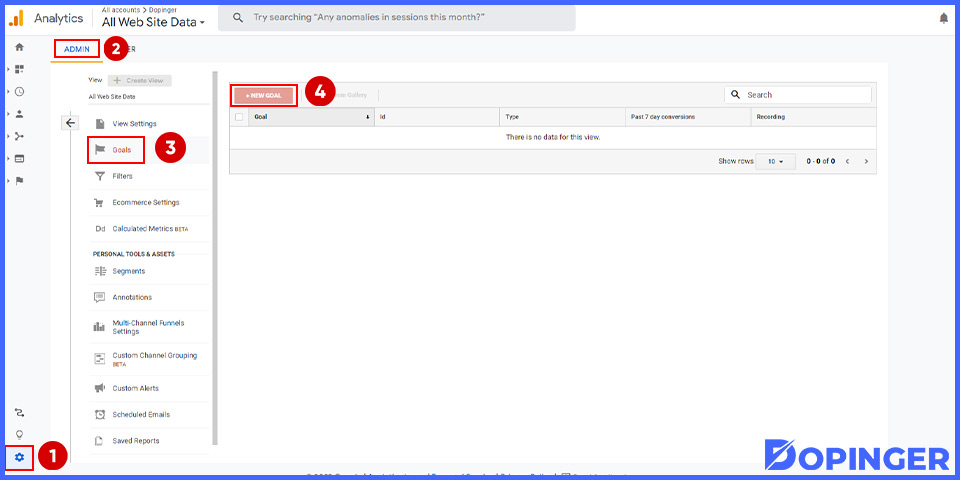
Google Analytics goals are directly linked to your business’s actual gains, be it in terms of revenue or conversion rate. This is also why the main components of those goals are often referred to as goal conversions and completion. If we break it down schematically: you want your visitors to engage in a specific action that would benefit you (goal). When this happens, you succeed (completion) precisely because the visitors have taken a direct and desired action (conversion). We will have a deeper look at all this in the next sections.
Goal Types in Google Analytics
Google Analytics allows you to track 20 goals per view. There are four main goal types in Google Analytics, each with specific purposes. Let’s see what they look like.
URL Destination Goals
As pointed out by the name, a URL destination goal is tracking URLs. In other words, this is when you check out the visitors landing on specific pages of your website, such as add to cart section, thank you page, PDF content, etc. Destination goals are of utmost importance for tracking significant activities and rates. They can keep you updated about the number of new users accounts created, downloads, and/or sign-ups for materials like newsletters. This kind of goal tracking requires a few steps:
- Select ‘Admin’ at the bottom of the left tab.
- Among the view columns displayed, pick up the View column and select ‘Goals’ there.
- Select ‘New Goal’ and go to the bottom of the Goal setup section. Click ‘Custom.’
- Name the goal by being as clear as possible. For example, don’t write something like ‘Goal no. 1’. Instead, be precise and write an indication like ‘Thank You Page.’
- At the bottom of the page, you will see the different goal types. Choose ‘URL Destination’ and then click ‘Continue.’
More About Destination Goals
Don’t worry; you are almost done. Once arrive at your Destination (pun intended), there are just a few more things to take into account:
- Assign a value: Assigning a value is an optional step, but it can still be useful to know your average revenue. This can be determined as follows: if you have one lead out of 10 leads who becomes an actual client, you have to look at the profit generated by this lead. The Value must be set to the ‘On’ position to keep such tracks. You can then type the relevant Value.
- Set a funnel: Arranging a funnel is optional as well. It all depends on whether you want or not your visitors to land on specific pages like, for example, a contact form. If yes, then the form must be included in a funnel. Ensure that Funnel is set to the ‘On’ position and write a name for the form page. Don’t forget the URL ending for the page in question. Remember that funnels are not the best solution when the form is on the home page or when you are working on multiple pages.
- Verify this Goal: Let’s suppose that the Google Analytics code and the form are set up for at least seven days. Let’s also suppose that the form was completed during those days. In such a case, you should see a conversion rate greater than 0 when clicking ‘Verify this Goal.’ If not, a problem may have occurred while setting up your goals, so you must check it out.
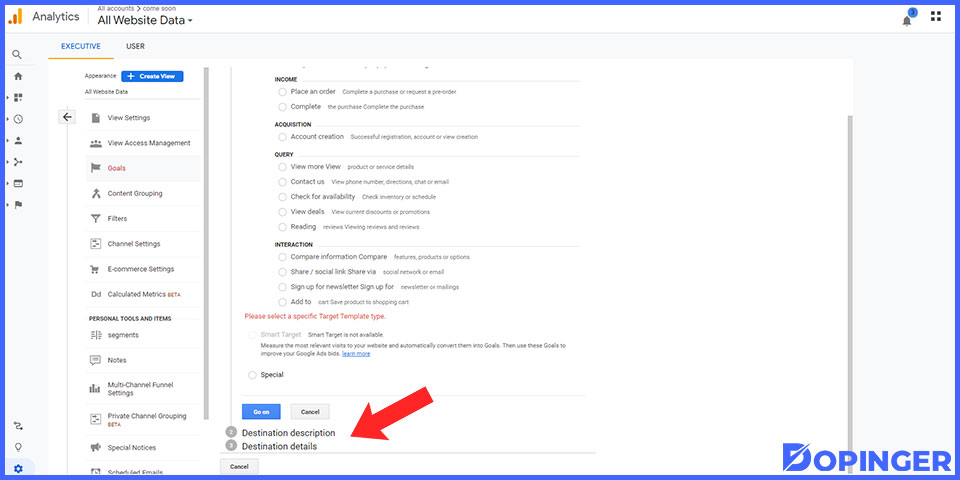
After Completing The Destination Goals
After completing those steps, you can click ‘Save’ and visualize your goals on the Goals page. A word of caution here: Goal URL and Match Type sections can often lead to mistakes. For the Goal URL, don’t type the entire domain, but only what comes after the domain name. So, for example, if the full URL is something like; www.inflatablemugs.com/contact,’ you should only enter ‘/contact.’ As for the match type, try to avoid selecting ‘Exact Match’ if each visitor is assigned a unique URL. Generally speaking, regular expression appears to be a good alternative when one has to avoid too much exactitude. Even if the symbolic language of regular expression may be confusing while getting started, you can quickly get used to it, thanks to the available online tutorials.
Duration Goals
Once again, the name says it all: duration goals simply indicate how long a visitor has been hanging out on your website. You may consider them as a sort of fidelity rate. On the other hand, this is also a somewhat tricky part. As a matter of fact, there is no ideal duration set in stone. It can vary from one website to the other and depend on the visitors: while some may convert after 5 minutes spent on your site, others may need less or more time.
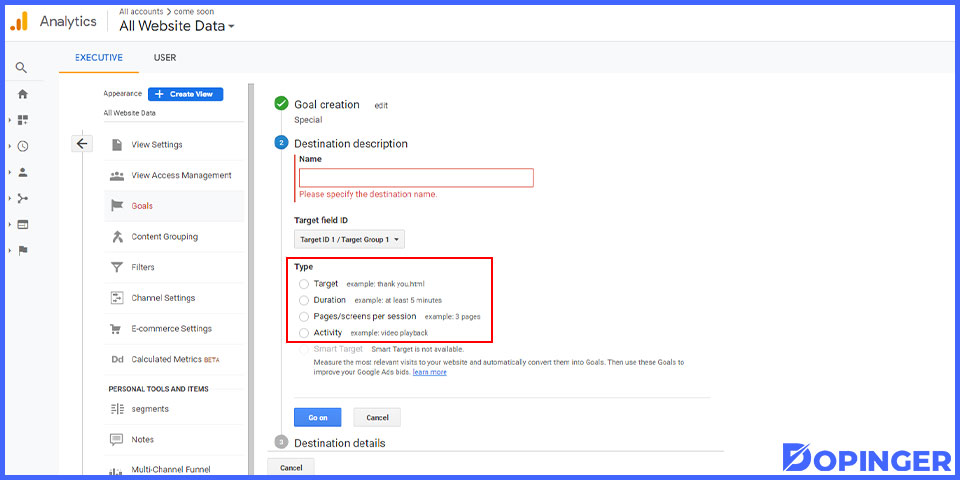
Either way, you can set duration goals in the Goal Type section (mentioned above when discussing Destination goals) by selecting ‘Visit Duration.’ You can then enter an exact time (in terms of hours, minutes, or seconds) as a goal. Remember that time stamps collected through this method are not the most reliable indication regarding conversion. Indeed, they don’t always make a clear distinction between simple clicks on your site and actual visits. So you will need to evaluate the duration parameter over time by using additional measures.
Pages/Screens Per Session Goals
Pages/screens per session is another self-explanatory term. It is an indication of the number of pages or screens that your visitors do open per session (or visit). If you set up a minimum number of pages or screens beforehand, the goal is considered achieved when a user visits that number (or more) of pages or screens within the same session.
To set this goal up, you must use the Goal Type section and select ‘Page/Visit’ (the third option on the list). As for the Goal Details section, you will have the following options: greater than, equal to, and less than. Your choice will depend on what you intend to measure. If it is the engagement level, choose greater than; if it is the effectiveness of your support site, then less than is a better option.
Event Goals
An event goal may be a little more sophisticated than the previous ones. Indeed, the term event refers to a larger set of actions the visitor performs, but not always necessarily revenue-oriented. You can track various events linked to downloads, widgets, or the time spent by the visitor watching your videos. In the Goal Type section, choose ‘Event.’ Now, you will have to decide what kind of events you consider to be goals. In the Goal Details section, you will see the following event-tracking features:
- Category
- Action
- Label
- Value
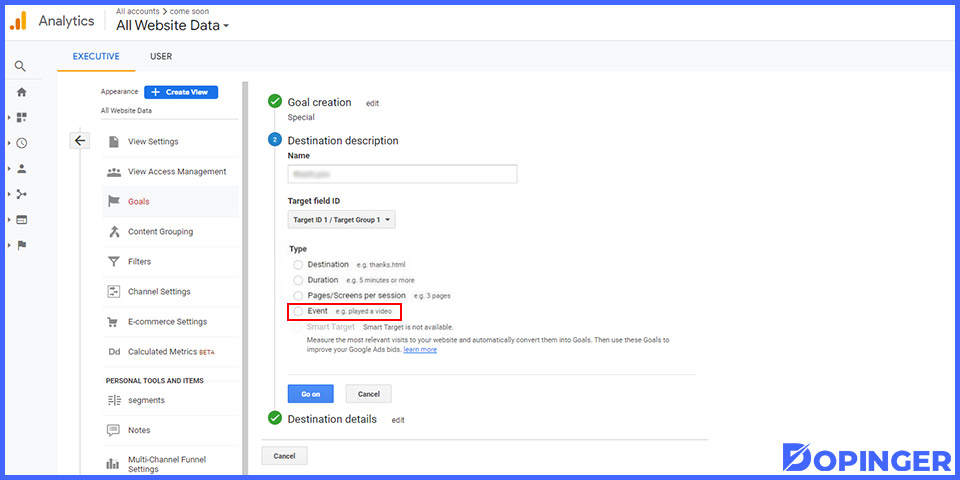
It’s up to you to choose how many of them you will activate. The goal will consider only the type of event you have selected and ignore the rest. So, for example, if you only activate ‘Label,’ the system will ignore the other ones.
But if you select all of them, the goal will be considered activated only if the event matches them.
You will also have a second option regarding the Value: you can use the actual event value or a constant value. It will depend on whether you want to pair up the event and goal values. This can be a good idea when the Value is related to the revenue. Another option is to leave the goal value blank. One important thing to remember here is that event goals cannot be used in a funnel. Remember, the steps of a funnel should always be expressed in terms of URL.
Smart Goals
These are the ‘+1’ or bonus goals that can be set up in Google Analytics. This new type of goal can be viewed as a more advanced feature and thus accessible only under certain conditions. One of the conditions is to have a minimum of 50 sessions in Google Ads within 30 days. Smart Goals are based on an algorithm principle. Thanks to those algorithms, the system can scan many signals in your website sessions and thus determine the potential/future conversions.
Signals can also be defined as factors including duration, the number of pages visited, location, browser type, etc. The session is successful when these combined factors reach a threshold beforehand (or initial objective). Consequently, sessions rated with the highest scores are ready to become Smart Goals.
The setup process is quite easy and smart. All you have to do is to go to the Goals section and click ‘New Goal.’ Then you can select ‘Smart Goal’ (if you are eligible to use it), give a specific name to your goal, and save it.
Where is The Goals Part on GA4?
If you use Google Analytics regularly, you may hear updates about it. Universal Analytics is now its last days and the time to fully use GA4 is approaching. Every time you enter Google Analytics, you can see the warning that Universal Analytics will expire on July 1, 2023.
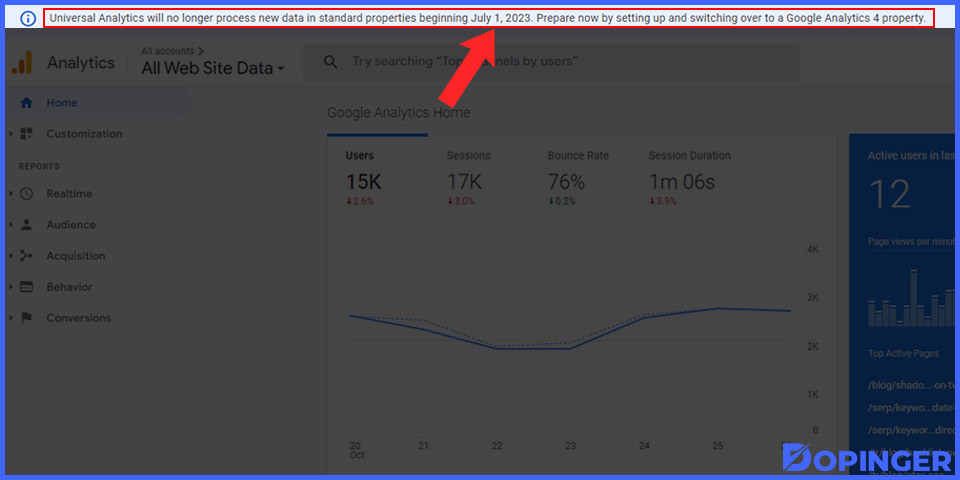
In this situation, there are many updates on GA4 and many things changed or disappeared. You may wonder what will happen to the Goals part. You can use the Goals feature on Universal Analytics until July 1, 2023, however, you will not be able to use it on GA4. There are no “Goals”, you need to use the part of the conversion. The logic is the same but there is a difference in usage. You can follow the steps below;
- Click on “Configure”.
- Choose the “Create event” option.
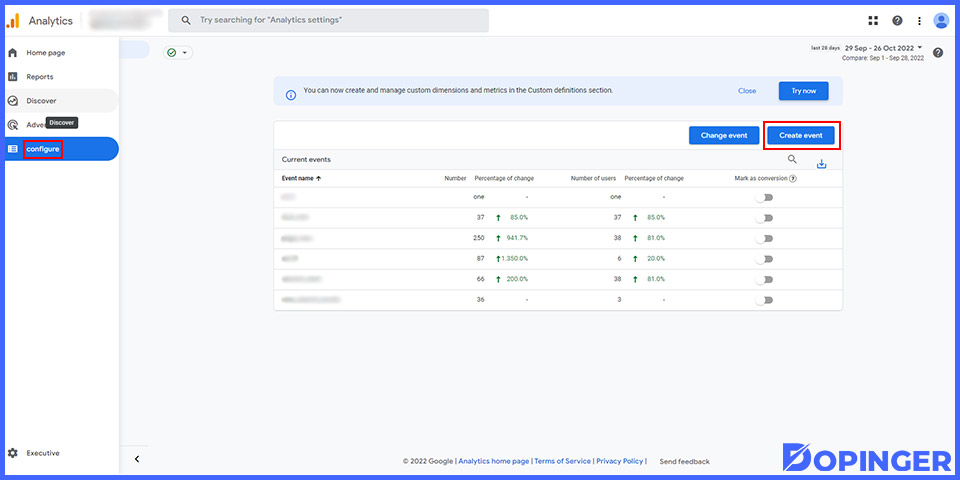
Although the names and usage patterns change, the purpose is the same. GA4, which has a simpler interface, provides a simpler use. Thus, don’t worry about radical updates, you can track events in an easier way.
Last Words About Google Analytics Goals
As you can see, Google Analytics Goals are quite complex yet accessible instruments. They can make a significant contribution to the success of your business. Since they are based on precise values, they naturally allow you to track your website’s activity with a more meticulous approach. Indeed, simple data such as the quantity of traffic is surely not enough to determine the ‘health’ of your business.
You need more sophisticated metrics to see whether visitors add value to your site and how they do that. In this context, not all roads lead to Rome. That is, not every action taken on your site nor every random visit is profitable. So creating goals by using the in-depth parameters of Google Analytics will enable you to explore additional ways to increase your revenue while eliminating waste.
Frequently Asked Questions About
Yes, there is. A goal in Google Analytics is almost always related to actions generating revenue for the website. In contrast, an event is a more general track that can include random online behaviors.
Not exactly. Goals and KPIs (Key Performance Indicators) are different concepts. However, you should try to keep them in a certain harmony since they complement each other. We suggest you get more information directly on Google support sites.
Conversions refer to successful interactions on your website and become more lasting relationships. Leads, customers, and subscribers are examples that fall under this category.
Google Analytics follows the data from all your marketing channels (including Google Ads). Google Ads conversion tracking is limited to the data from Google Ads only.
There are many popular and, above all, useful goals. Shopping cart funnels, click-to-contact, and order confirmation can be cited as examples. Your choice(s) will depend on several factors, such as your website’s general purpose, your target audience’s profile, your niche, etc.

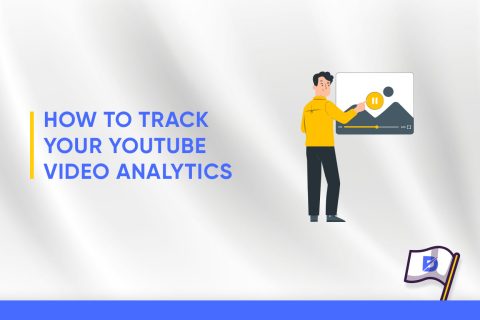


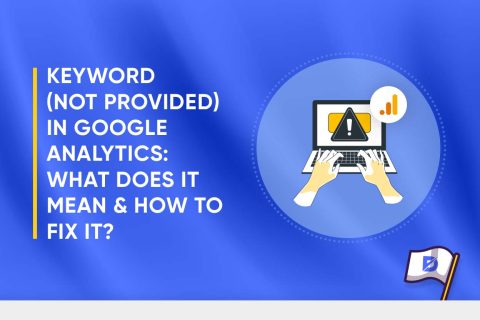
No comments to show.